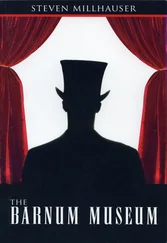A custom manufacturer of museum display cases was hired to construct a tempered glass case, eight feet high, in which the body of the mermaid was to be kept in a clear liquid preservative intended to prevent desiccation and permit easy viewing. Inside the glass case the designer placed a large boulder, closely resembling one of the black basalt rocks on our jetty; on it the mermaid was seated. Her torso was upright and her fishbody lay stretched across the rock, where it was held down by concealed grips. At the bottom of the case grew several water plants with long, spiky leaves.
The exhibit opened on June 26 at 9:00 in the morning. Within days it proved to be the largest attraction in the eighty-four-year history of our Historical Society. Cars with out-of-state plates lined the sycamore-shaded street, with its shuttered eighteenth-century houses and its new steel-and-glass recreational facility. Mothers and daughters, groups of wisecracking high school boys, visiting Girl Scout troops, and grandparents stooped over canes waited in line for nearly an hour before they found themselves face-to-face with the mermaid in her glass case. So many people reached out to touch the glass that one morning a blue velvet rope appeared, suspended between brass posts two feet from the display.
She sat on her rock with one hand resting by her side and one arm partly raised, the forearm lying on a bit of green netting stretched over small steel uprights driven into the stone. Her long hair was carefully draped over each breast so that it concealed the nipple and most of the breast itself, though there was only so much that could be hidden, and complaints were regularly made that the exhibit was unsuitable for public viewing. Her green eyes were open, her lips closed in what some thought was a faint smile. Her cheekbones were high, her air reflective; she might have been a local girl sitting in the ice-cream parlor, except for something vaguely foreign in her look, perhaps a slight narrowness in the ears, or something about the forehead, it was difficult to tell. Children pointed and whispered, older boys made coarse jokes — all this was to be expected. What no one had foreseen was the way she stayed in our minds long afterward. Day after day we returned to stand before the glass case and stare at our mermaid. She looked just to the right or left of us, or a little above, as if she were gazing off at a place we could never see.
It wasn’t long after her appearance among us that Rick Halsey, captain of the high school swim team, told a reporter standing near the display case that the mermaid was the best thing that had ever happened to our town and that he was going to throw a pool party in her honor. At the back of his parents’ house was a large in-ground swimming pool where he and his teammates liked to practice at night. Halsey was an easygoing young man with a wide circle of friends; the party was well attended. Girls arrived in mermaid bathing suits composed of bikini tops and long skirt-like bottoms that tightened at the ankles. Many of the lower halves glittered with sewn-on scales made of sequins. It was later said that a few female guests dispensed with tops and covered their breasts with nothing but their long hair. The party was reported in the “Friends and Neighbors” section of the Listener , with a color photograph of two laughing mermaids stretched out in lounge chairs by the poolside. The idea caught on quickly; mermaid parties sprang up all over town. Diana Barone, a local seamstress, created for her daughter the first bottom that concealed the feet and spread out in the shape of a tail fin. The wearer had to walk with her feet pointed to the sides. The new constriction in walking, which resulted in little mincing steps, proved surprisingly popular among high school and college girls.
It was only a matter of days before mermaid suits began appearing at our beach. You would see girls taking off their T-shirts and jeans to reveal the triangle tops and string bikinis of last season, only to reach into their beach bags and remove the new fishtail bottoms, styled in glittering scales of many colors. A local store offered an array of new suits, of which the most poplar was the Mermaidini: a skintight scaly bottom with zip-off tail fin and a bold bikini top with a realistic breast and nipple printed on each cup. Even bolder was the cheveux top, or Mermette, which consisted of easy-to-attach clip-in hair extensions designed to cover the bare chest. All over the beach you could see them, the mermaids of our town: lying on their stomachs on beach towels, with their lower scales glistening in the sun; sitting on the rocks of the jetty and combing their long hair; laughing wildly as boys scooped them up and carried them wriggling down to the low waves, where they threw the mermaids high out over the water — for a moment you could see them hovering there, in the blue air, the shining sea-girls of summer.
Such changes in public fashion do not pass unnoticed in our town. From the first day, protests had arisen against the creature in the display case, who, whatever else she might be, was also a naked teenager indecently exposing her breasts in public. The protests intensified as the new styles erupted on our beach. Mermaid suits, it was said, encouraged women to display their breasts for the delectation of male voyeurs; the constriction of fish-bottoms at the ankles caused women to walk in a new, provocative manner, more suitable for the bedroom than the beach. The tight-ankled style, moreover, disabled women in a backward-looking way reminiscent of the corset and the hobble skirt. Defenders of the new costumes pointed out that the scaly bottoms covered the lower body entirely and were far more modest than the string and thong bikinis they replaced; the painted breasts, which some found so disturbing, concealed the real breasts far more completely than the skimpy tops of recent fashion. Even the much-criticized cheveux tops were broad and thick and protected the breasts from view, at least when the women were out of the water. As for the issue of constriction, the defenders yielded no ground: the tight fishtails, they claimed, were worn in a spirit of play, of sheer fun, even of bravado, which narrow-minded ideologues bound by crippling dogmas were incapable of comprehending.
As charges and countercharges burst forth at town meetings and in the local paper, young mothers with toddlers began appearing at the beach in the new costumes; children emerged from cars in gaudy fishtail suits; and even older women were soon wearing modified, looser versions, which, whatever their drawbacks when it came to ambulation, were welcomed as a convenient method of protecting the lower body from the sun’s malignant rays and, in some cases, of concealing varicose veins or fatty accumulations on the hips and thighs.
But the new beach fashions, however striking, were only the most visible sign of a fascination that struck much deeper. We knew that a mermaid had washed up on our beach. Wasn’t it likely, wasn’t it more than likely, that others should be nearby? From the first announcement of her appearance among us, mermaid sightings were reported daily. Each claim was immediately and scrupulously investigated. A second-grade math teacher, Martha Lloyd, was sitting on a blanket on the beach at dusk when she saw a mermaid rise from the water not far from shore. The mermaid looked directly at her before diving under. What struck Mrs. Lloyd was the uncanny resemblance of the young mermaid to the one in our display case — the face was older, but the cheekbones and eyebrows looked so familiar that Mrs. Lloyd was certain she had seen the girl’s mother. The next night two witnesses reported seeing a mermaid sitting on the last rock of the jetty. In the moonlight they could see her slightly bowed head, her darkly gleaming scales. There were more unusual sightings: a mermaid seated on the rim of the rotunda in the duck pond in the public park at nightfall, a mermaid under a backyard spruce tree. Joseph Ernst, a retired building contractor, saw a mermaid in his bedroom one night, but she disappeared when he approached. Eight-year-old Jenny Wheeler ran screaming from her bubble bath when she saw a child mermaid rising from the far end of the tub, but when she returned to the bathroom with her mother, the mer-child was no longer there.
Читать дальше












